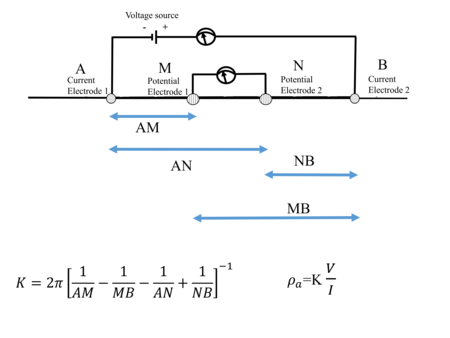A single measurement results in two values: a current and a voltage. These are associated with the current and voltage electrode positions. The ratio between the voltage and current is known as the transfer resistance. By considering the geometry of the electrodes we can calculate a geometric factor K (see the figure on the left) which can be used to calculate what is known as the apparent resistivity ρ a (which is given in Ohm.m). The apparent resistivity is used extensively for visualization as it allows a simple way to compare measurements done with different electrode spacings. Note that (for historical reasons) the current electrodes are often referred to as A and B, and the potential electrodes as M and N.
 The apparent resistivity is not the true subsurface resistivity (except in the case of a homogeneous subsurface). In fact, the apparent resistivity can be negative dependent on the actual values of subsurface resistivities, so a single apparent resistivity value is of limited interest and value.
The apparent resistivity is not the true subsurface resistivity (except in the case of a homogeneous subsurface). In fact, the apparent resistivity can be negative dependent on the actual values of subsurface resistivities, so a single apparent resistivity value is of limited interest and value.
Or, in order to obtain information on the subsurface distribution of electrical properties we need to collect multiple resistivity measurements with different electrode locations and geometries. This collection is typically referred to as an electrical resistivity survey - where the survey both refers to the actual collection in the field and the resulting measurements.
By combining these different measurements as input in our processing and inversion process we can now obtain our goal: information on the subsurface distribution of electrical properties.
Historically there were two kind of surveys (sounding and profiling surveys). Currently many other types of surveys exist, each of which has a specific purpose. Details on the different kind of surveys which are commonly encountered, on electrode geometries used with these surveys and on data display of the data collected in these surveys are provided in a detailed section on surveys.
The important concept to keep in mind in studying different surveys is that each survey has as objective the collection of information on the distribution of electrical properties of the subsurface. Thus, there is not one best survey type which fits each problem, but the survey type should be selected as a function of a specific site, underlying question and available instrumentation.